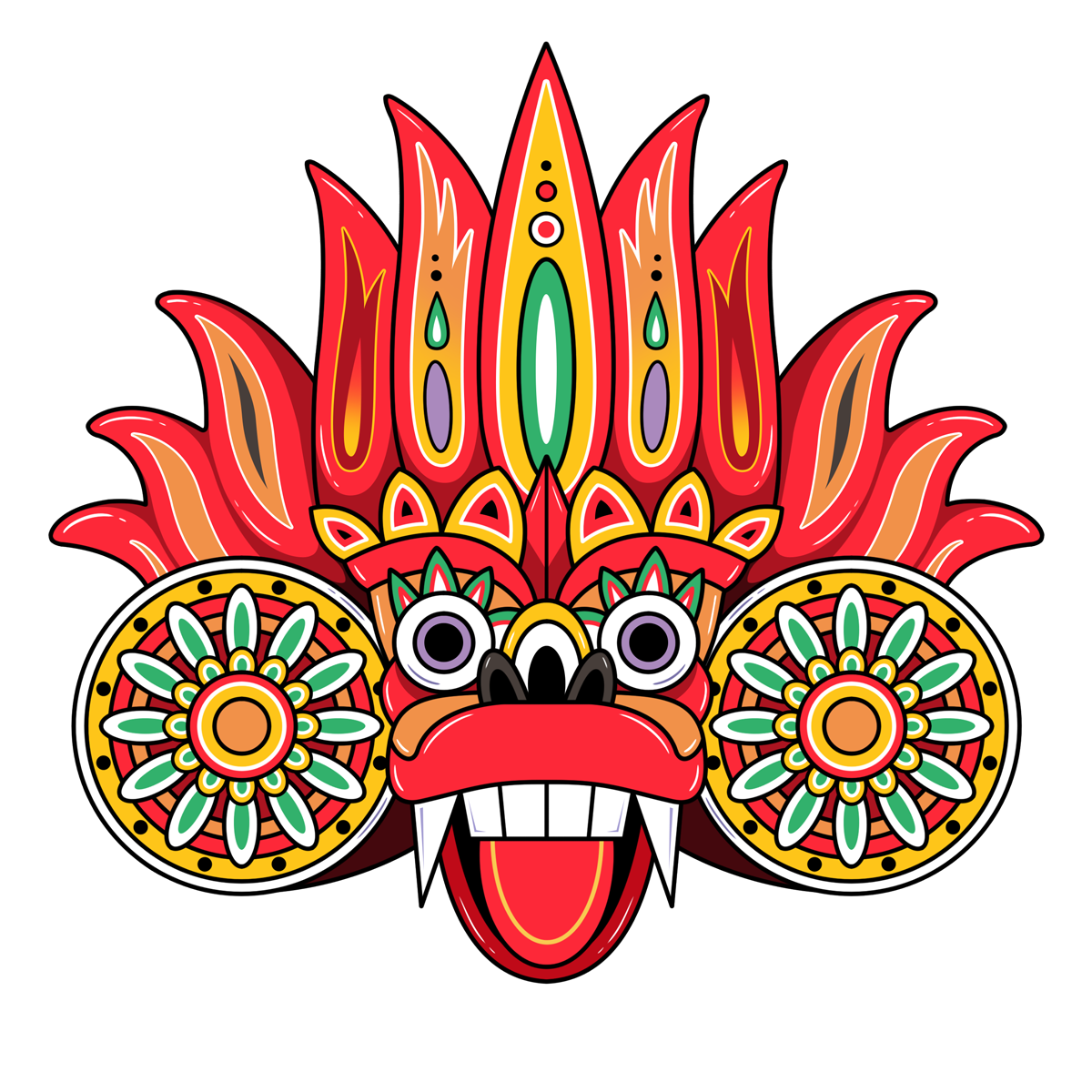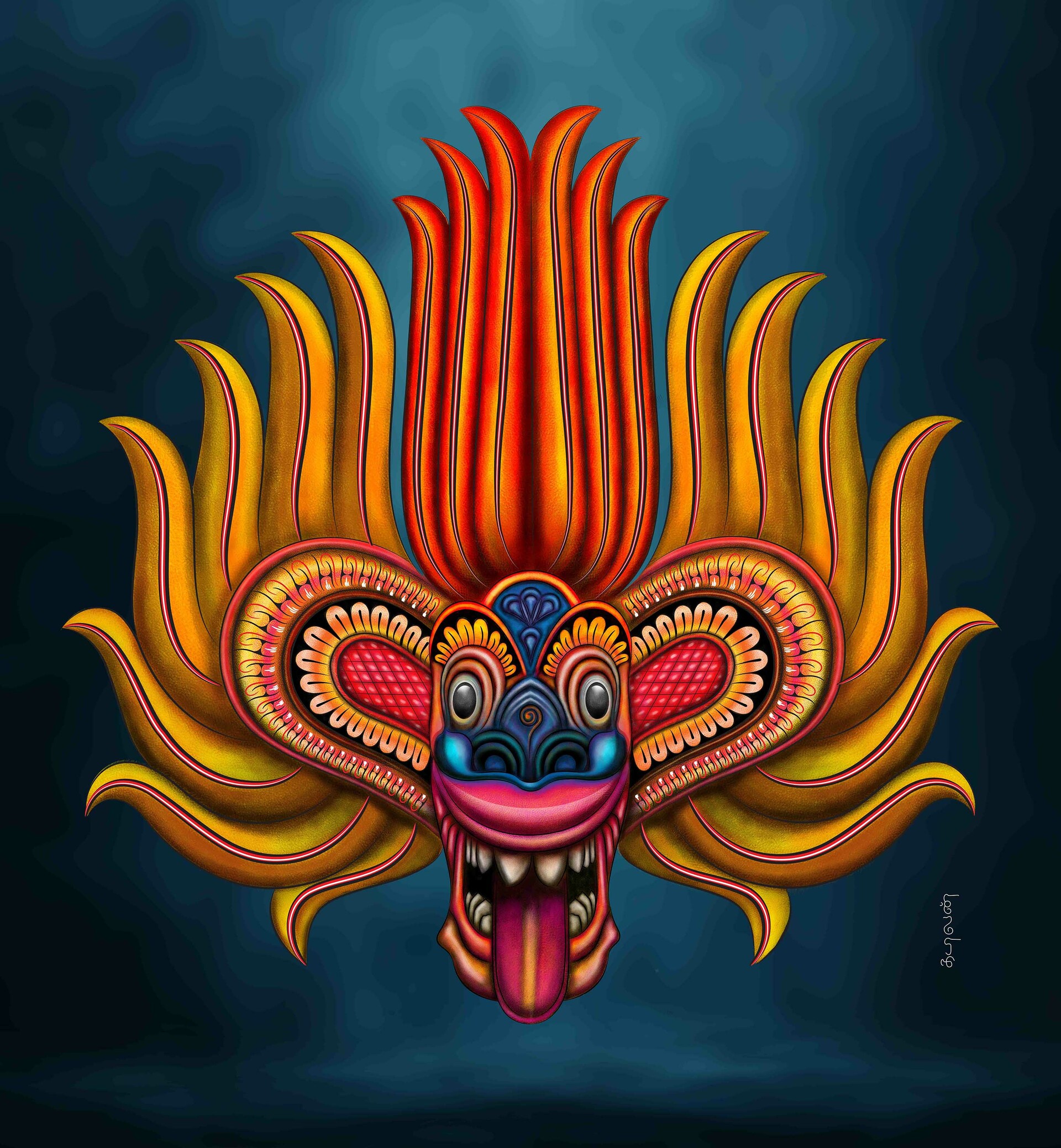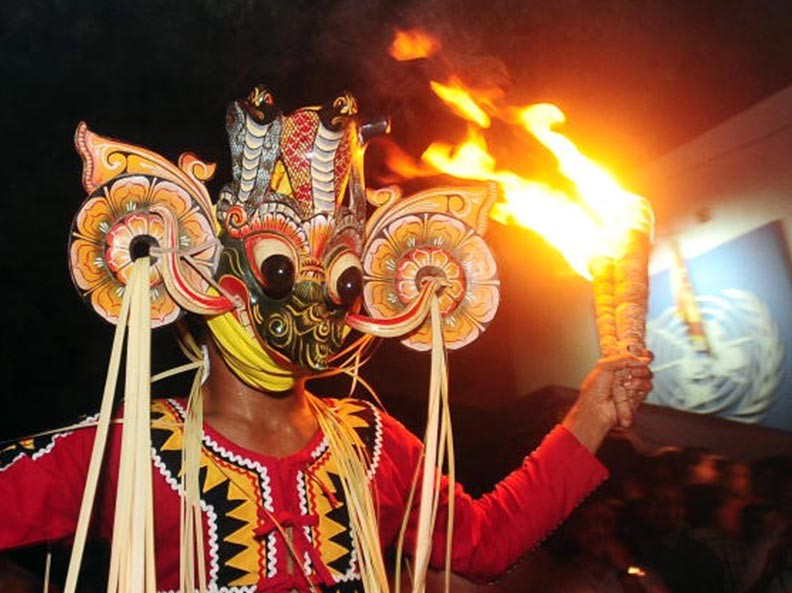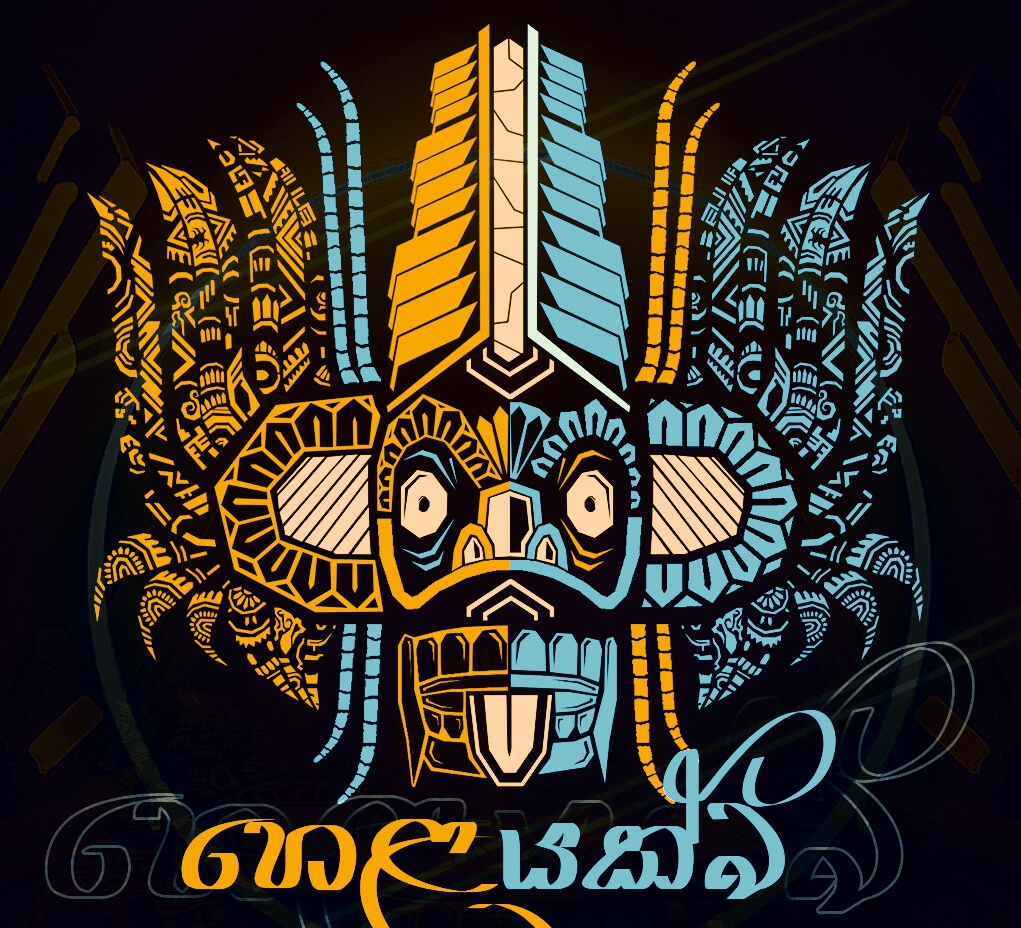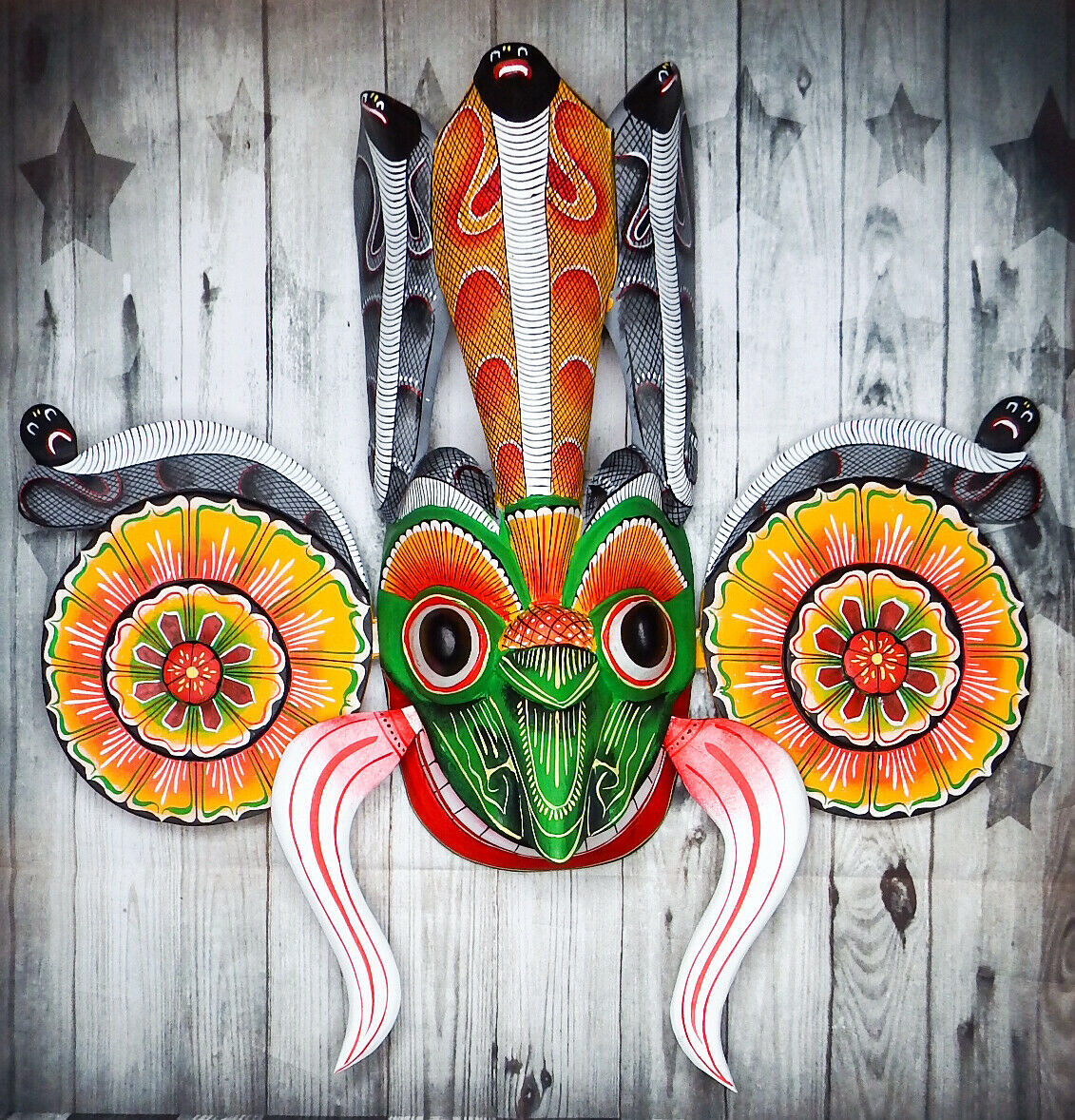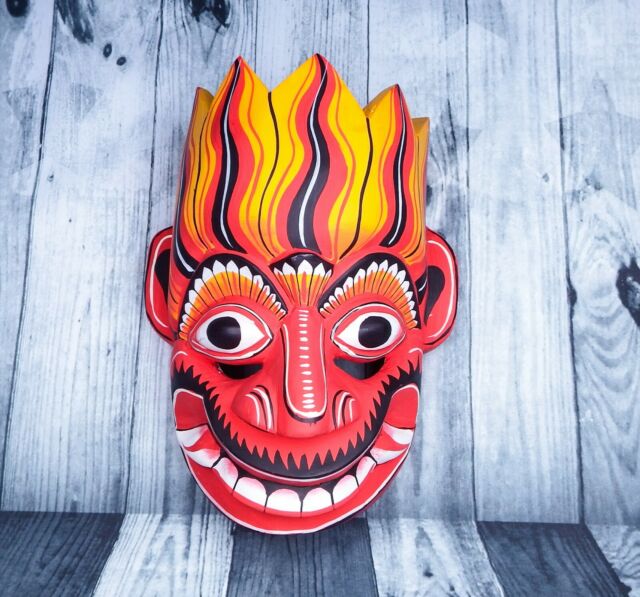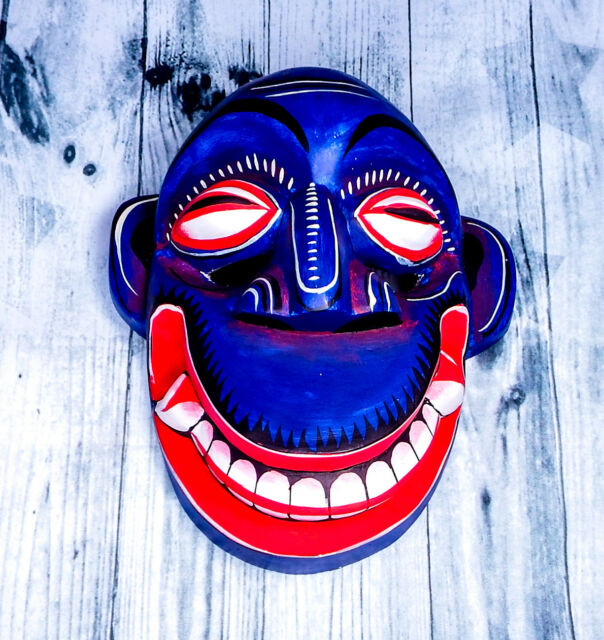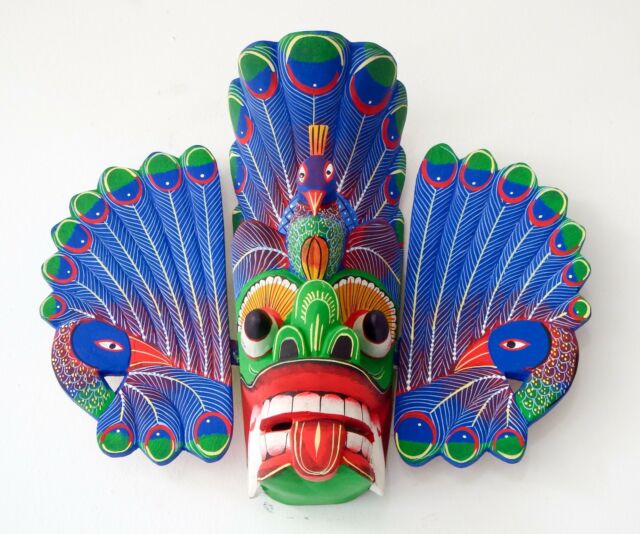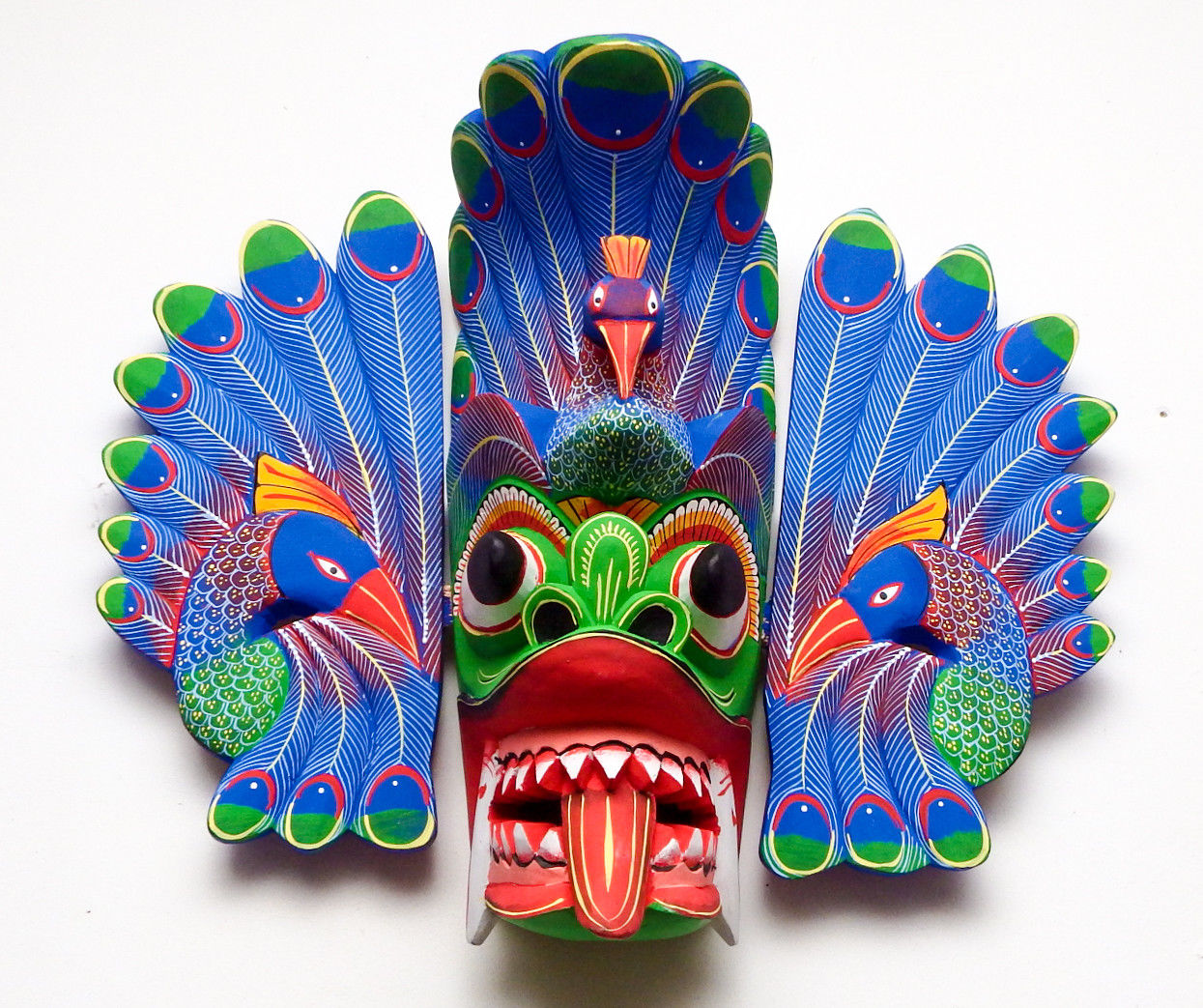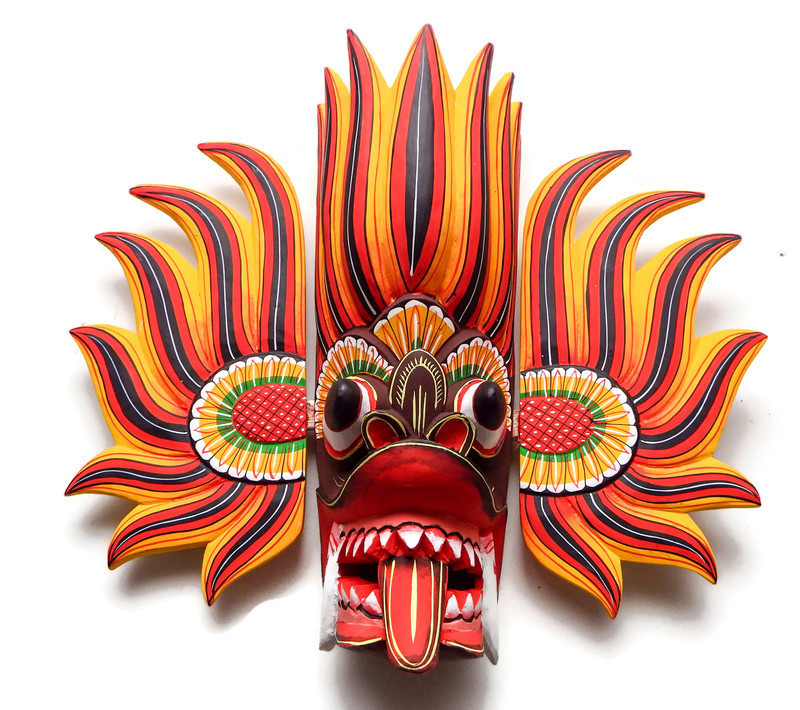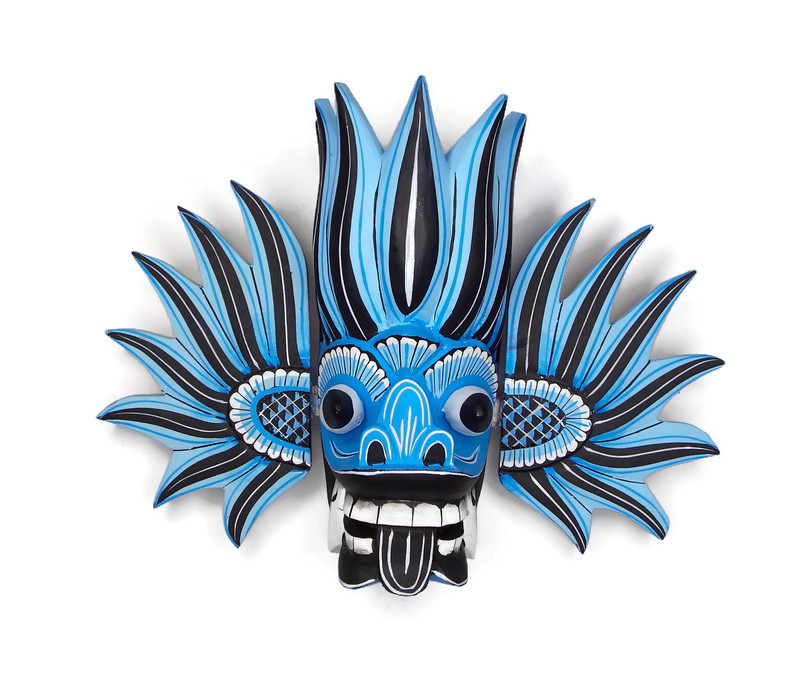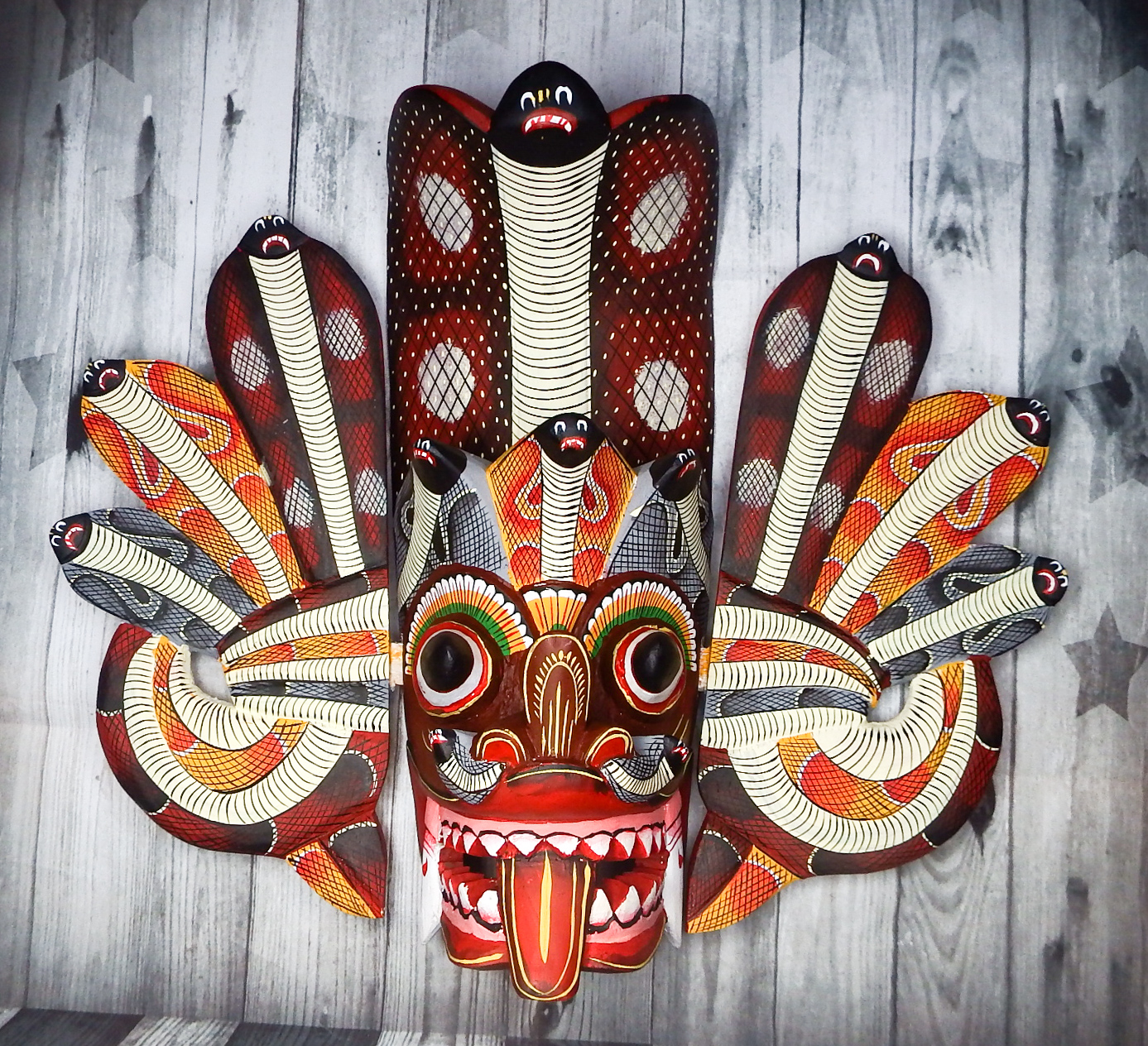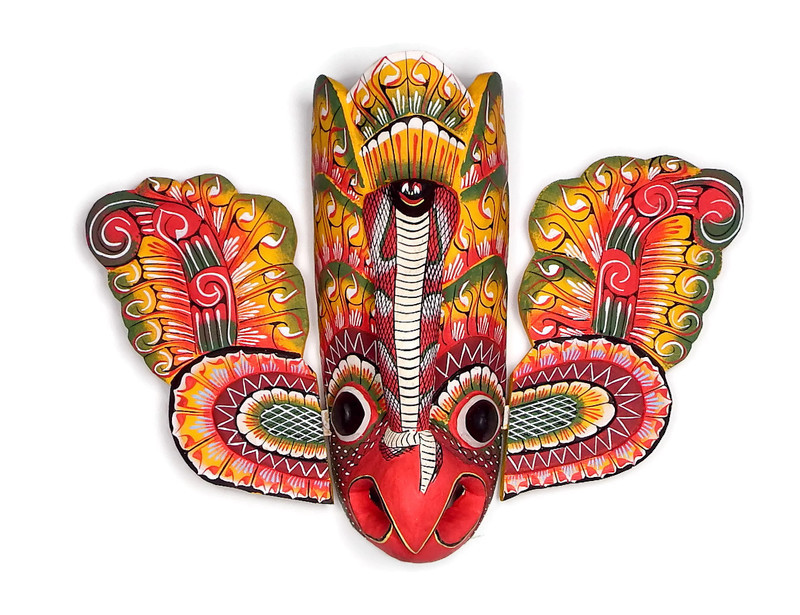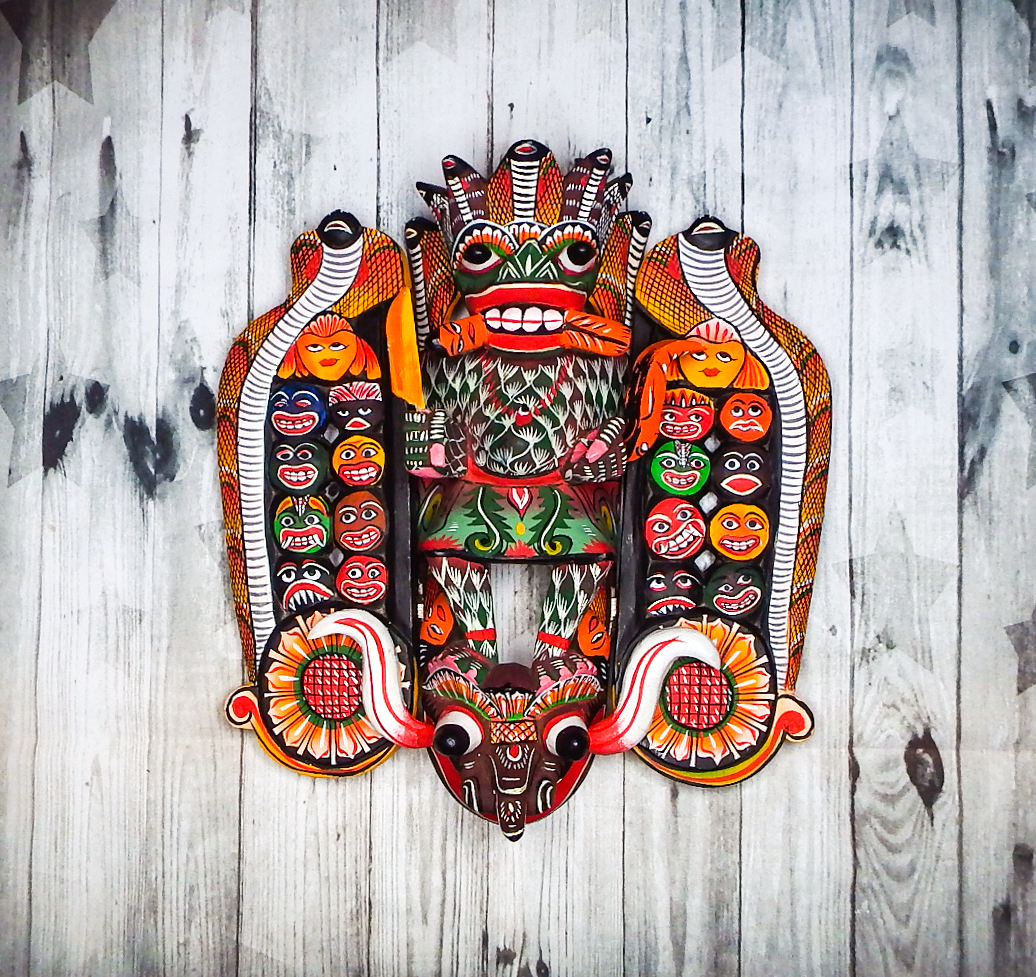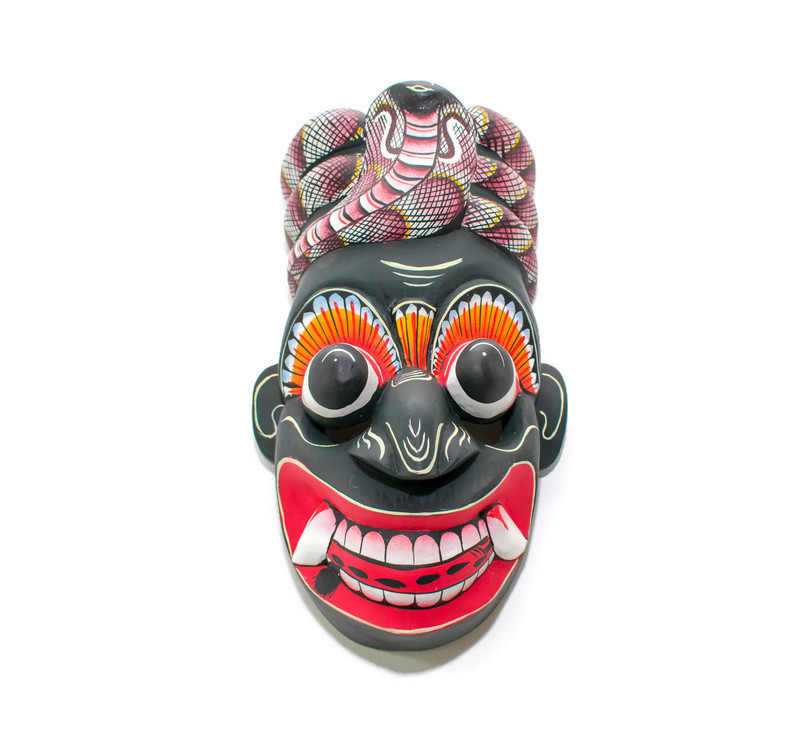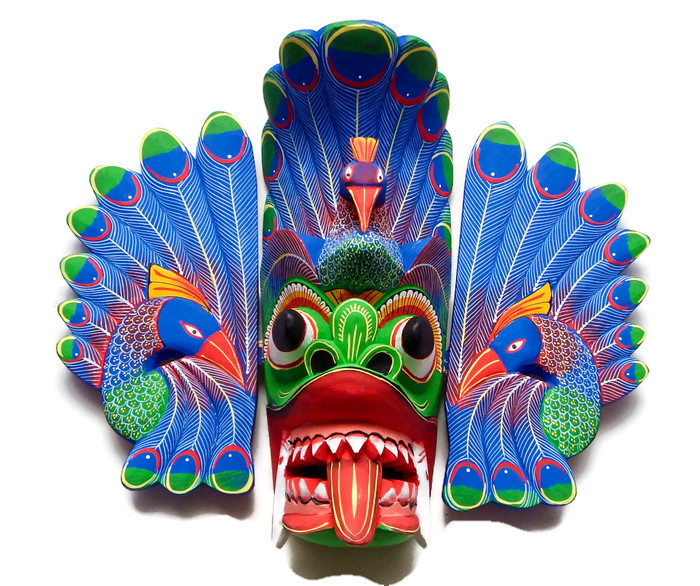Sanni yakuma, sometimes known as Daha ata sanniya is a traditional Sinhalese exorcism ritual. The ritual consists of 18 masked dances, each depicting a particular illness or ailment affecting humans. These 18 dances are the main dances of the Pahatharata, or low country, dancing form, which is one of the three main dancing forms of Sri Lanka. The ritual calls the demons who are thought to affect the patient, who are then told not to trouble humans and banished.
Every demon has an identity, a story. Unlike among the Balinese, where demons often represent types (i.e., hero, villain, clown, etc.), the Sinhalese yakku represent individual demons whose lineages and exploits are recited and commemorated. The masks used in the various rituals are carved to represent particular demons and can, with some exceptions, be specifically identified. Although the yakku. seem limitless in number, there is a core group of eighteen which form the focus for the yakun natima rituals.
Known as the daha-ata sanni yakka, these demons represent specific afflictions, both mental and physical, which commonly afflict the Sinhalese villagers. Although the number eighteen has now become standard, indications are that this number has decreased over time. Nor are the identities of the eighteen consistent. Different areas, or even different communities within the same area, will count different demons among the list.
Paul Wirz, in his seminal work Exorcism and the Art of Healing in Ceylon (1954), lists the following demons and their effects: Kana-sanniya (blindness), Kora-sanniya (lameness/paralysis), Gini-jala-sanniya (malaria), Vedda-sanniya (bubonic plague), Demala-sanniya (bad dreams), Kapala-sanniya (insanity), Golu-sanniya (dumbness/muteness), Biri-sanniya (deafness). Maru-sanniya (delirium). Amuku sanniya (vomiting), Gulma-sanniya (parasitic worms), Deva-sanniya (epidemic disease, i.e. typhoid, cholera), Naga-sanniya (evil dreams particularly with snakes) (7), Murta-sanniya (swooning, loss of consciousness), Kala-sanniya (black death), Pita-sanniya (disease related to bile) (8), Vata-sanniya (shaking and burning of limbs), and Slesma-sanniya (secretions, epilepsy).
Surveys by individuals such as Alain Loviconi and E.D.W. Jayewardene, have demonstrated significant differences between various areas and the impossibility of creating a universally recognised list. One area might include 0lmada sanniya (babbling) and another area Avulun sanniya (breathing difficulties, chest pains). Contemporary ethnographers such as Obeyesekere have also noted the addition of certain more contemporary maladies to the list. For example Vedi sanniya as relating to gunshot wounds, dramatically reflecting the change in times and the adaptability of this indigenous system.
Although there is no single, uniform list or all eighteen demons, certain demons do seem consistent and universal, such as Biri for deafness, Kana for blindness (9), and Golu for dumbness.
Presiding over these eighteen yakku is the demon known as the Kola sanni yakka (10), a composite demon containing and regulating the other eighteen. In the yakun natima it is appeasing the Kola and gaining his benediction that is most important. His origin story, as recorded by Wirz, is as follows:
A certain king left for a great war, leaving behind his queen. He was unaware that she was pregnant. Upon his return he found his wife to be in an advanced state and ready to give birth. A handmaid to the queen, through lies and deceptions, convinced the king that it was not his child but that of the war minister, who had remained behind. In a fury he ordered the queen tied to a tree and cut in two. The child managed to survive, living off the remains of his mother. As he grew, the child vowed revenge on the father.
He gathered poisons from the different parts of the forest and formed them into eighteen separate lumps which transformed into demons. Kola sent these demons into the city and charged them to “capture humans and cause illness through wind, phlegm, and bile”.
Origins
It was believed that illnesses were brought on humans by demons and these beliefs and rituals could have prehistoricroots. According to folklore, the 18 demons who are depicted in the Sanni Yakuma originated during the time of the Buddha. The story goes that the king of Licchavis of Vaishali suspected his queen of committing adultery and had her killed. However, she gave birth when she was executed and her child became the Kola Sanniya, who grew up "feeding on his mother's corpse". The Kola Sanni demon destroyed the city, seeking vengeance on his father, the king.[5] He created eighteen lumps of poison and charmed them, thereby turning them into demons who assisted him in his destruction of the city.[6] They killed the king, and continued to wreak havoc in the city, "killing and eating thousands" daily, until finally being tamed by the Buddha and agreed to stop harming humans.[7]
Each of these demons are believed to affect humans in the form of an illnesses, and the Sanni Yakuma ritual summons these demons and banishes them back to the demon world after bringing them under control.[7] Although it is unclear when the ritual began, it has been performed in the southern and western parts of the country since ancient times.
Ritual
The name of the ritual comes from the Sinhala word sanniya meaning disease or ailment, and yakuma meaning demon ritual. In Sri Lankan culture, exorcism rituals are known as tovil. The Sanni Yakuma is possibly the best known exorcism ritual in the country.[10] It is a mix of traditional beliefs regarding spirits with Buddhism. Before performing the healing ritual, the lead performer known as the yakadura determines whether the patient is affected by a demon, and schedules the ritual for an auspicious day and time, usually from dusk to dawn.[13] The Edura or Yakadura is the Shaman healer and is usually a fisherman, drummer or farmer.[4][14] It has two main stages, namely the Ata Paliya and Daha Ata Sanniya.[15] The dancers are dressed in colourful attire and masks, and perform swift and complex dance steps and spins accompanied by rhythmical drum beats.[16] Rather comic and somewhat obscene dialogues take place between the drummer and the demon on stage, in which the demon is humiliated.[15][17] For example, Moore and Myerhoff (1977) describe the following dialogue translated from Sinhala:
Drummer: Where are you off to?
Demon: I am off to Maradana by a first class express bus.
Drummer: ...What was it I saw you doing only yesterday? You pissed near the sacred bodhi tree, then shitted on the temple grounds after which you stole a monk's robes. What else have you done? ...
Demon: You peretaya![N 2]
Drummer: Aah – you are only a mad demon – beneath contempt.
Ata Paliya
Ata Paliya is the name given to the eight dances in the first stage of the ritual. Before the dances begin, the Yakadura prepares some offerings for the demons, which will be given to them by the patient. The Ata Paliya depicts eight palis who bless the patient. This includes the Suniyan Yakshaniya who appears thrice as a beautiful damsel, a pregnant woman and a woman carrying a baby. This is followed by Maruwa (death) and demons called Kalu Yaka, Vatha Kumara and Kalu Kumara. The other palis are known as Anguru Dummala Paliya, Kalaspaliya and Salupaliya.[18]
Daha Ata Sanniya
Although the Daha Ata Sanniya is part of the Sanni Yakuma, the name is sometimes used to refer to the ritual itself. This is the stage when the sanni demons make their appearance one after the other. The demons who first appear frightening when they enter the stage in frenzied dances are then shown as comic figures through enactments, with them being humiliated and forced to do various things. The Kola Sanni demon enters last, who is depicted as a non Buddhist demon. In the end, he is made to obtain the permission of the Buddha and accept offerings from humans, and agrees to stop troubling them.[19] In the end, the dancer appears before the patient after removing the mask.[20]
Although there are only eighteen demons, there is a variety of sanni masks that differ from place to place.[12] However, the eighteen most commons masks (and names of the demons) are as follows:[21]
| Demon | Associated ailment |
|---|---|
| Amukku Sanniya | Vomiting and stomach diseases |
| Abutha Sanniya | Non–spirit related insanity |
| Butha Sanniya | Spirit related insanity |
| Bihiri Sanniya | Deafness |
| Deva Sanniya | Epidemic diseases |
| Gedi Sanniya | Boild and skin diseases |
| Gini Jala Sanniya | Malaria and other high fevers |
| Golu Sanniya | Dumbness |
| Gulma Sanniya | Parasitic worms and stomach diseases |
| Jala Sanniya | Cholera and chills |
| Kana Sanniya | Blindness |
| Kora Sanniya | Lameness and paralysis |
| Maru Sanniya | Delirium and death |
| Naga Sanniya | Bad dreams about snakes |
| Pissu Sanniya | Temporary insanity |
| Pith Sanniya | Bilious diseases |
| Slesma Sanniya | Phlegm and epilepsy |
| Vatha Sanniya | Flatulence and rheumatism |
Current status
The Sanni Yakuma is still performed today, particularly along the south coast, though more often as a cultural spectacle than an exorcism ritual. However, it is not widely performed because of the high costs involved and also because of its long duration.[9][18][22] The 2004 Indian Ocean earthquake and tsunami also has affected its survival.[23][24] Though the coastal regions came under colonial influences as well as prior foreign influences, the art was best preserved in the south-west coast.[4][14]









